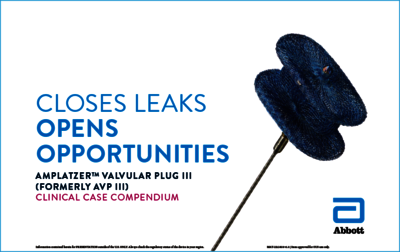VALVULAR PLUG III
STRUCTURAL INTERVENTIONS
Paravalvular leaks (PVLs) are a common and challenging problem around the world.1 The Amplatzer™ Valvular Plug III is specially designed to provide an effective solution to this key issue, improving quality of life and longevity for an increasing number of patients.2–5
A SOLUTION TO A KEY ISSUE
Around the world, PVLs are a common and challenging problem, occurring in 7% to 17% of mitral valve replacements (MVRs) and 5% to 10% of aortic valve replacements (AVRs).1 Risk factors for PVL development include: annular calcification, tissue friability, prior endocarditis, or other inflammatory processes, and recent initiation of corticosteroid therapy.8 PVLs can occur soon after valve replacement or several years later.2,6
By providing an effective solution to this key issue, the Amplatzer™ Valvular Plug III is improving quality of life for an increasing number of patients.2–5
LEARN MORE:
Hub
HUB
- Rama-Merchan J, Arribas-Jimenez A, et al. Prevalence and severity of paravalvular regurgitation in the Artificial Valve Endocarditis Reduction Trial (AVERT) echocardiography study. Rev Esp Cardiol. 2014;67:593-596.
- Ruiz CE, Hahn RT, Berrebi A, et al. Clinical trial principles and endpoint definitions for paravalvular leaks in surgical prosthesis: an expert statement. J Am Coll Cardiol. 2017;69(16):2067-2087. doi.org/10.1016/j.jacc.2017.02.038.
- Calvert PA, Northridge DB, Malik IS, et al. Percutaneous device closure of paravalvular leak: combined experience from the United Kingdom and Ireland. Circulation. 2016;134(13):934-944. doi.org/10.1161/CIRCULATIONAHA.116.022684.
- García E, Arzamendi D, Jimenez-Quevedo P, et al. Outcomes and predictors of success and complications for paravalvular leak closure: an analysis of the SpanisH real-wOrld paravalvular LEaks closure (HOLE) registry. EuroIntervention. 2017;12(16):1962-1968. https://doi.org/10.4244/EIJ-D-16-00581.
- Davidavicius G, Rucinskas K, Drasutiene A, et al. Hybrid approach for transcatheter paravalvular leak closure of mitral prosthesis in high-risk patients through transapical access. J Thorac Cardiovasc Surg. 2014;148(5):1965-1969. doi.org/10.1016/j.jtcvs.2014.05.001.
- Smolka G, Pysz P, Jasinski M, et al. Multiplug paravalvular leak closure using Amplatzer Vascular Plugs III: a prospective registry. Catheter Cardiovasc Interv. 2016;87(3):478-487. doi.org/10.1002/ccd.25992.
- Yildirim A, Goktekin O, Gorgulu S, et al. A new specific device in transcatheter prosthetic paravalvular leak closure: a prospective two-center trial. Catheter Cardiovasc Interv. 2016;88(4):618-624. doi.org/10.1002/ccd.26439.
- Angulo-Llanos R, Sarnago-Cebada F, Rivera AR, et al. Two-year follow up after surgical versus percutaneous paravalvular leak closure: a non-randomized analysis. Catheter Cardiovasc Interv. 2016;88(4):626-634. doi.org/10.1002/ccd.26459.
- Data on File at Abbott.
- Sánchez-Recalde A, Moreno R, Galeote G, et al. Immediate and midterm clinical course after percutaneous closure of paravalvular leakage. Rev Esp Cardiol (Engl Ed). 2014;67(8):615-623. doi.org/10.1016/j.rec.2014.01.031.


